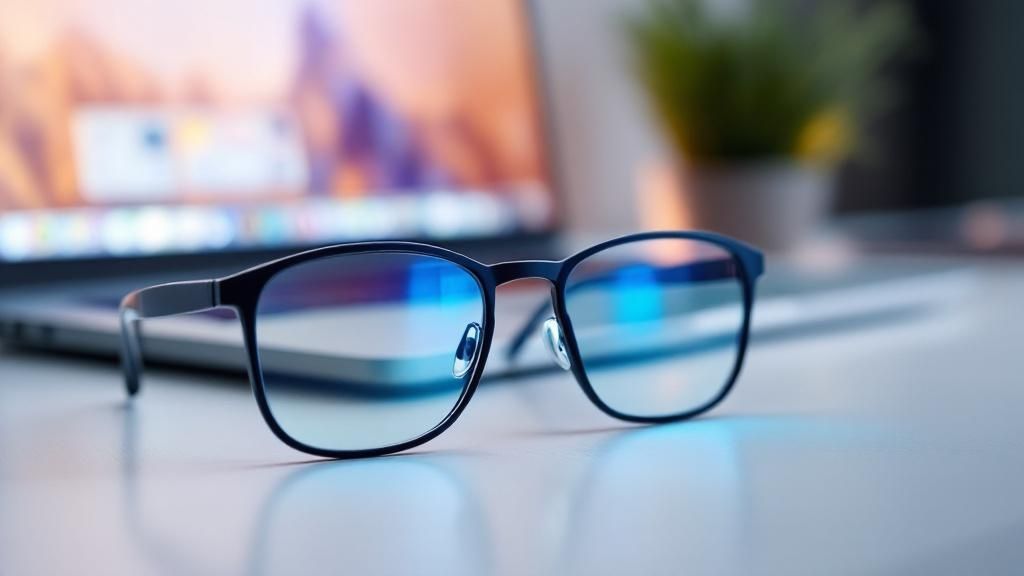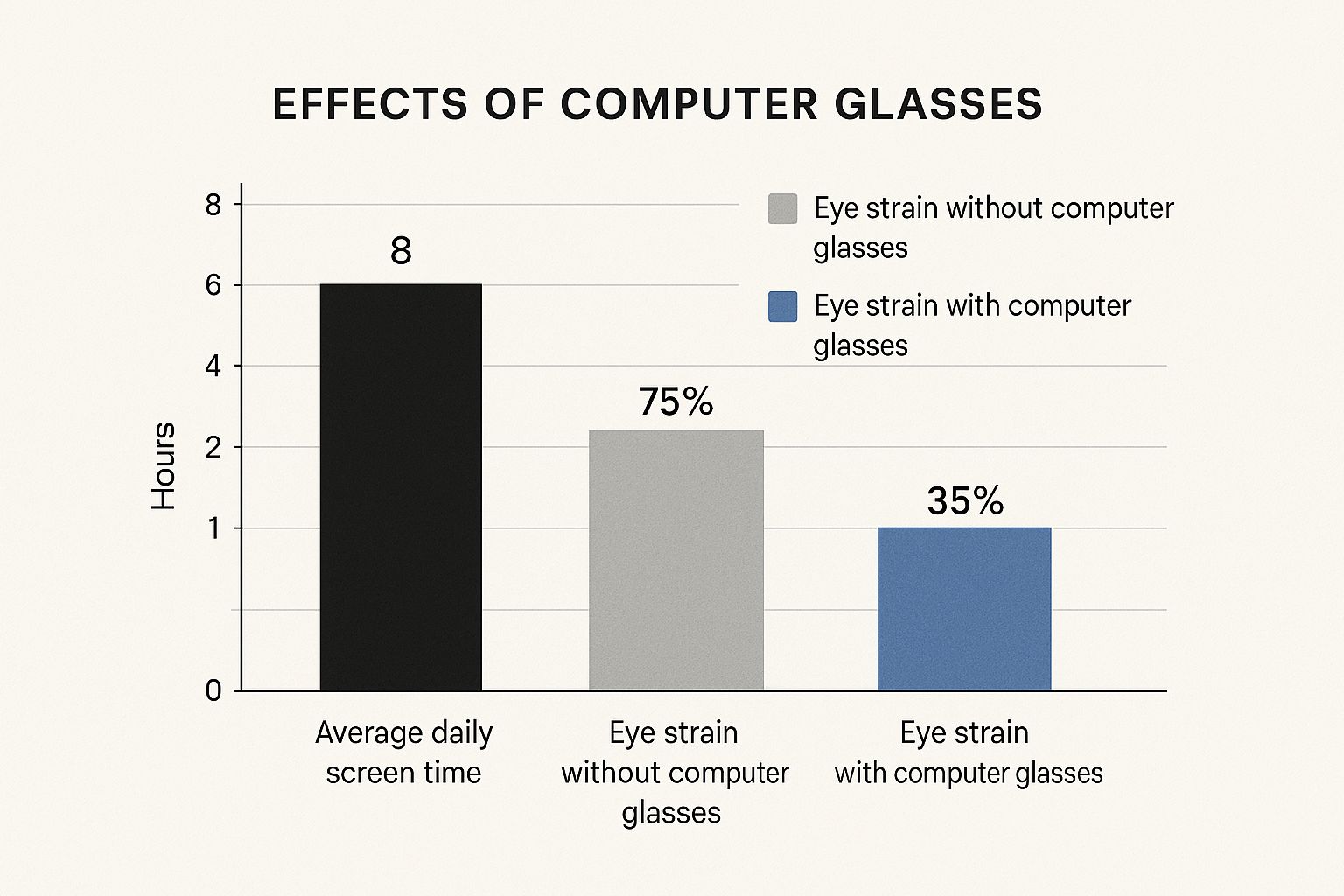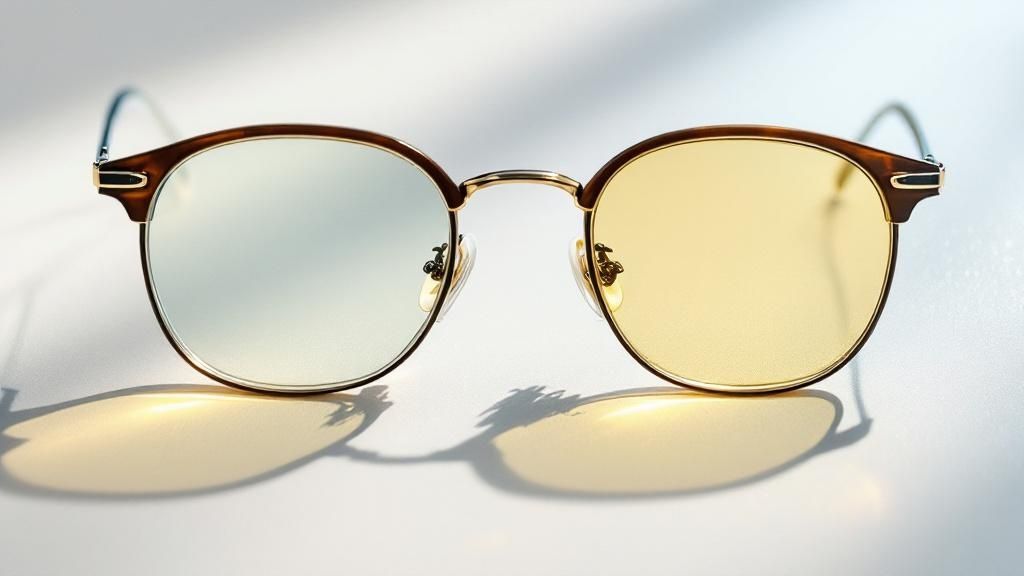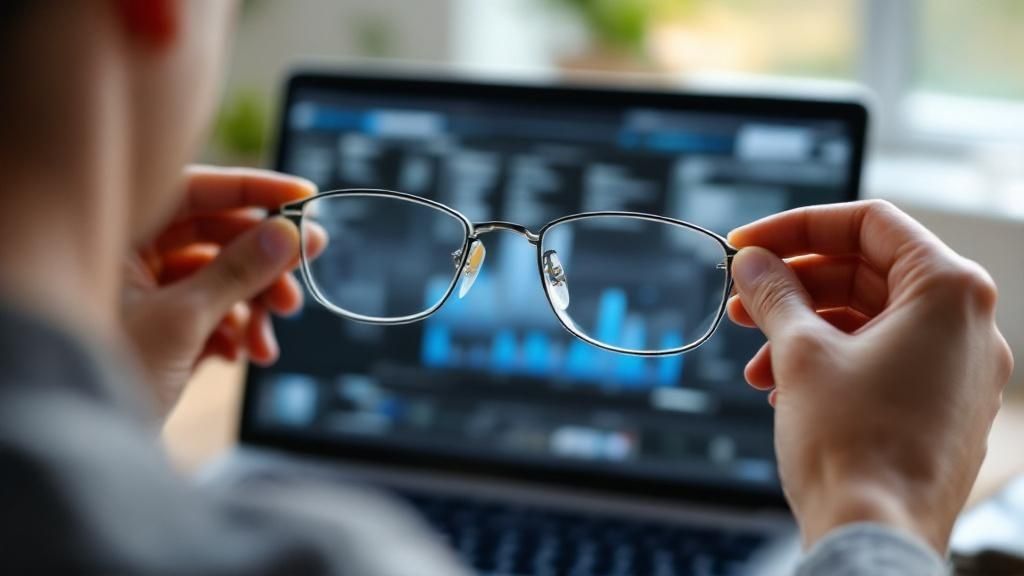
A Guide to Glasses for Computer Eye Strain
If you've ever finished a long day of screen time feeling like your eyes have run a marathon, you're not imagining it. That gritty, tired, and strained feeling is a very real condition known as Digital Eye Strain. The best way to combat it? Specialized glasses for computer eye strain.
It’s a simple analogy, but it holds up: you wouldn't run a marathon in dress shoes. So why are you asking your eyes to handle hours of intense digital work without the right gear?
Why Your Eyes Get Tired From Screens
That nagging headache, the blurry vision, or the constant urge to rub your eyes after a long workday? You’re definitely not alone. The discomfort is a direct result of your eyes working overtime to focus on bright, pixelated screens. This relentless effort puts a major strain on your eye muscles, kind of like how lifting weights at the gym fatigues your biceps.
Let's get to the root of it. Our eyes simply weren't built for the unique demands of digital displays. Unlike the crisp, solid letters on a printed page, the text on a screen is made up of thousands of tiny dots called pixels. Your eyes are in a constant state of micro-adjustment, struggling to maintain a sharp focus on these less-defined images, which inevitably leads to fatigue.
The Rise of Digital Discomfort
This issue has become almost universal as our work lives have shifted. To really grasp why computer eye strain is so prevalent, you have to look at how our modern work habits have changed, especially with the evolving landscape of office and remote work. The numbers really tell the story.

As you can see, the data is pretty stark. Wearing the right kind of glasses can slash the reported incidence of eye strain by more than half. That’s a huge difference in daily comfort and productivity.
This widespread need has, of course, created a massive market. As of 2025, the demand for computer and gaming glasses has pushed the market to a valuation of around $2.5 billion, and it's still growing fast. This boom is entirely driven by people seeking relief and adopting the lens technologies that are specifically designed to tackle digital discomfort.
Common Digital Eye Strain Symptoms and How Computer Glasses Help
It's helpful to connect the dots between what you're feeling and how these specialized glasses actually fix the problem. This table breaks it down.
| Symptom You Feel | What Your Screen Is Doing | How Computer Glasses Solve It |
|---|---|---|
| Blurry Vision & Focus Issues | Your eye muscles are constantly refocusing on pixelated text. | The slight magnification in the lenses reduces the focusing effort your eyes need to make. |
| Headaches & Eye Fatigue | High-energy blue light and screen glare force your eyes to work harder. | Blue light filters cut down on harsh light, while anti-glare coatings minimize distracting reflections. |
| Dry, Itchy, or Watery Eyes | You blink less when staring at a screen, causing your eyes to dry out. | By reducing overall strain and glare, the glasses help your eyes relax, promoting more natural blinking patterns. |
| Neck & Shoulder Pain | You're leaning in or squinting to see the screen clearly. | The optimized focus means you can maintain a more natural, comfortable posture without craning your neck. |
Ultimately, computer glasses are an ergonomic tool for your eyes, tackling the specific stressors of screen use head-on so you can work and play more comfortably.
The Truth About Blue Light from Your Devices
So, what’s the real story with the blue light coming from our screens? Think of all the light we can see as a big rainbow, or a spectrum. On one end, you have the longer, lower-energy red light. On the other end, you find the shorter, high-energy blue-violet light. This blue part of the spectrum has a more intense, "jittery" wavelength.

When this high-energy light beams from your laptop or phone into your eyes, it scatters more than other colors. This scattering effect forces your eyes to work harder just to keep things in focus. It's a huge reason why you feel that familiar digital eye strain and mental fatigue after a long day staring at screens.
How Blue Light Messes With Your Sleep
But the issue with blue light isn’t just about eye comfort—it goes much deeper, right into your brain's sleep signals. This specific wavelength is especially good at fooling your brain into thinking it’s the middle of the day, even when it's dark outside. It achieves this by slamming the brakes on your body's production of melatonin, the hormone that tells your body it’s time to sleep.
This is why scrolling through your phone in bed can lead to a night of tossing and turning. You're actively disrupting your body's natural sleep-wake cycle, also known as its circadian rhythm. By filtering out this specific light, glasses for computer eye strain act as a shield for your melatonin production. This allows your body to wind down naturally, even if you’ve been on your tablet late into the evening.
By directly interfering with your body’s sleep signals, blue light from screens can create a vicious cycle where poor sleep quality makes you more susceptible to eye strain the next day.
This connection between screen time, eye health, and sleep isn’t just a niche concern anymore; it’s why blue light blocking glasses have become so popular. In fact, the global market for these glasses was valued at $2.9 billion in 2024 and is expected to nearly double by 2034. This growth is fueled by our simple, everyday reliance on digital devices.
Understanding the science behind blue light is the first step. To dig even deeper into the research, you can check out some of the key blue light studies and information.
How Anti-Glare Lenses Create a Clearer View

While blue light gets most of the attention when we talk about screen use, it's really only half the story. Have you ever been distracted by the reflection of an overhead light or a bright window on your glasses? That visual interference is called glare, and it forces your eyes to work constantly harder just to see what’s on your screen.
Think of it like trying to read through a smudged window. Your eye muscles have to keep readjusting to focus past all that visual "noise," which is a fast track to squinting, fatigue, and headaches. This ongoing battle with reflections is a huge contributor to digital eye strain.
This is exactly where anti-glare, or anti-reflective (AR), coatings make a world of difference. These are microscopic layers applied directly to your lenses to manage how light interacts with them.
Reducing Visual Noise
An anti-reflective coating acts like a sophisticated bouncer for light. Instead of letting light bounce off the lens surface and create that annoying glare, the coating ushers more clean, focused light straight through to your eye. In fact, top-tier AR coatings can allow up to 99.5% of available light to reach your eyes.
This process drastically cuts down on the visual static your eyes have to fight. The result is a much sharper, clearer, and more comfortable view of your screen. If you want to dive deeper into how this works for screen time, there are some great guides on anti-glare glasses for computer use.
By getting rid of reflections from both the front and back of your lenses, an anti-glare coating delivers a crisper, more relaxed visual experience. It lets your eyes concentrate on your work, not on distracting light.
This is precisely why the best glasses for computer eye strain always pair blue light filtering with a high-quality anti-glare coating. While the right lenses are key for screen glare, it’s also smart to think about your surroundings. Learning how to reduce glare from windows in your office or home can help create the most comfortable viewing setup possible.
The Real-World Benefits of Computer Glasses
So, what happens when you actually start wearing a pair of glasses for computer eye strain? It’s one thing to talk about technology, but the real-world improvements are what truly count. The most immediate benefit you'll notice is a feeling of sustained visual comfort throughout your day.
This means you can get through an eight-hour workday without that desperate urge to rub your eyes or grab for lubricating drops. Imagine hitting 5 PM feeling visually relaxed instead of completely fried. By filtering out harsh light and cutting down on glare, these glasses let your eye muscles work more efficiently, not harder.
The positive effects go beyond just comfort. Many people report a huge drop in both how often and how intensely they get screen-related headaches. When your eyes aren’t constantly fighting visual noise and strain, that tension that often builds into a nagging headache just seems to melt away. This is a game-changer if your productivity is regularly derailed by eye-related pain.
Better Focus and Deeper Sleep
It makes sense that when your body feels better, your mind works better. With less physical discomfort to distract you, your mental clarity gets a serious boost. You can maintain focus for longer, making you more productive and engaged, whether you're coding, writing, or designing. Your concentration won't dip because of tired eyes; you can stay locked in.
By alleviating the physical symptoms of eye strain—like fatigue and headaches—computer glasses free up mental resources, allowing you to direct your full attention to the task at hand.
Finally, one of the most powerful benefits kicks in after you've logged off. By filtering out disruptive blue light in the evening, computer glasses help protect your body's natural production of melatonin. This helps you wind down more naturally, fall asleep faster, and enjoy higher-quality rest.
You’re not just buying clearer vision for your workday; you're investing in a tool that supports better sleep and daily recovery. It's this combination of benefits that makes these specialized glasses an essential part of any modern professional's toolkit.
Choosing the Right Computer Glasses for Your Needs

Trying to select the perfect glasses for computer eye strain can feel like a chore, but it really just comes down to your daily habits and what you need them for. The best pair isn't just about filtering blue light; it's about finding the right combination of lens tech, comfortable fit, and prescription for how you use your screens.
Think of it like buying running shoes—what works for a marathoner isn't what a sprinter needs. Are you a designer who needs flawless color accuracy, or a late-night coder who needs the strongest protection possible? Figuring that out is the first step.
Deciding on Lens Tints
Your most important decision is the lens tint because it dictates how much blue light gets filtered out. It generally breaks down into two main types:
-
Clear or Lightly Tinted Lenses: These are your daily drivers. They're perfect for daytime use because they block a good amount of harmful blue light without messing with your color perception. If you're a graphic artist, video editor, or anyone whose work depends on seeing true-to-life colors, a nearly clear lens is what you need.
-
Amber or Yellow Tinted Lenses: These are the heavy hitters, built for maximum blue light filtering. The amber tint blocks a much bigger slice of the blue light spectrum, which makes them fantastic for anyone using screens in the evening or at night. They're a favorite among gamers and coders looking to protect their natural melatonin production for better sleep.
Do You Need a Prescription?
Next, you'll need to figure out if your glasses require a prescription. Even if you don't normally wear glasses for distance or reading, a custom pair might still be beneficial.
If you already have a prescription, getting computer glasses made for it is a must. But if you have 20/20 vision, you can simply go for non-prescription (or "plano") lenses that still provide all the blue light filtering and anti-glare benefits. If you're on the fence, our guide can help you figure out if you need computer glasses.
The fit of your glasses is just as important as the lenses. Frames that are too tight can cause headaches, while a pair that constantly slips down your nose is a distraction. Look for lightweight materials and a comfortable bridge fit for all-day wear.
As more people become aware of digital eye strain, the demand for these specialized glasses has shot up. The global market is growing fast, with North America at the forefront thanks to high device usage and consumer awareness. In fact, the market is projected to grow at nearly 8% CAGR through 2030, showing a worldwide move toward making eye health a priority.
Frequently Asked Questions About Computer Glasses
Even after getting the facts, it’s completely normal to have a few more questions pop up before you decide on a new pair of glasses. To help you feel confident in your choice, we’ve put together some quick, straightforward answers to the things people ask us most about computer glasses.
Are Computer Glasses a Gimmick or Do They Really Work?
They absolutely work, and it's not magic—it's just smart lens technology. Computer glasses are designed to tackle the two main culprits behind digital eye strain: high-energy blue light and harsh screen glare.
Think of them less as a gimmick and more like an ergonomic tool for your eyes. Just as you wouldn’t wear dress shoes for a marathon, you shouldn't ask your eyes to handle hours of screen time without the right gear. They are a specific fix for a very modern problem.
Can I Just Wear My Regular Prescription Glasses?
While your everyday prescription glasses are great for general vision, they’re not built for the unique demands of staring at a screen. Computer glasses are fine-tuned for the intermediate distance to your monitor (usually 20-28 inches) and often include a slight magnification to make focusing feel effortless.
More importantly, they have crucial anti-reflective and blue light filtering coatings that most standard prescription glasses simply don't have. Using the right tool for the job makes all the difference in your daily comfort.
The best glasses for computer eye strain solve multiple problems at once. They combine an optimized focus for screen distance, anti-glare coatings to cut down visual noise, and blue light filtering to fight off fatigue and protect your sleep.
Should I Wear Computer Glasses All Day?
That really comes down to the lens tint. If your glasses have clear or very lightly tinted lenses, you can easily wear them all day long. They’re designed for professional environments where you need protection without any color distortion.
On the other hand, if your glasses have a more noticeable yellow or amber tint, they’re best reserved for the evening. These stronger tints are fantastic for blocking the maximum amount of blue light to help you wind down before bed, but the color shift isn't ideal for all-day use.
Ready to give your eyes the relief they deserve? The collection at Spektrum Glasses combines science-backed lens technology with stylish, comfortable frames to fight digital eye strain. Explore our glasses and find your perfect pair today.
